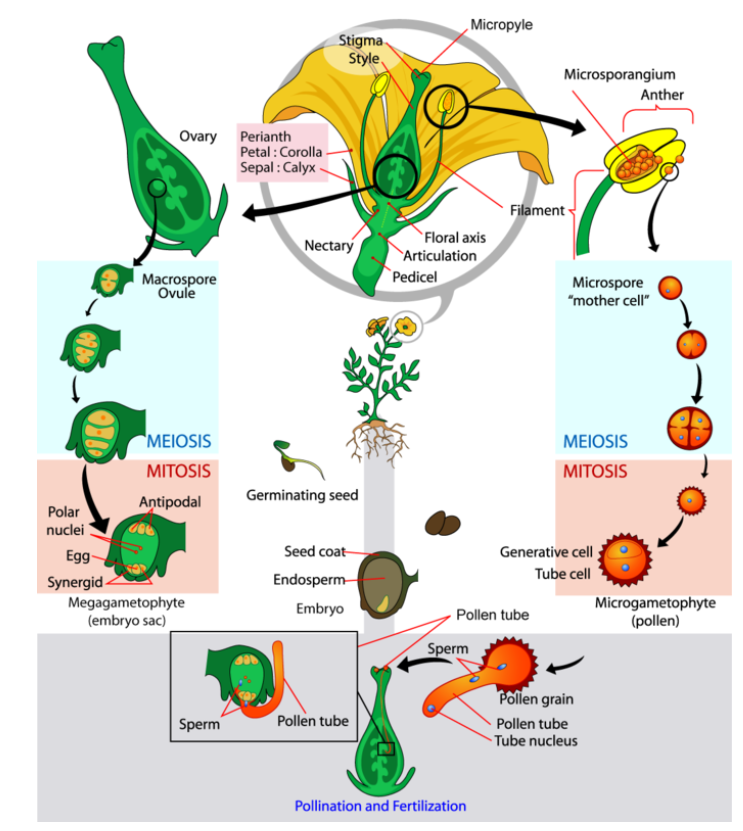
Describe the sequence of events as a dicot zygote becomes an embryo enclosed within a seed.
Answer
486.3k+ views
Hint: Cotyledons are found in dicots (on the left). Monocots, like maize (right), have only one cotyledon, the scutellum, which provides sustenance to the developing embryo. A plumule develops the leaves, a hypocotyl develops the stem, and a radicle develops the root in both monocot and dicot embryos.
Complete answer:
Dicot embryogenesis is substantially more sophisticated and distinct from monocot development. The germinated zygote is the starting point for embryogenesis.
The zygote differentiates into a proembryo, which is a two-cell structure. The basal cell is on one end of the cell, while the terminal cell is on the other. The terminal cell splits into a four-cell structure known as the quadrant stage, while the basal cell divides continually to create a long slender structure known as a suspensor.
The octant stage is formed when these cells divide again, forming an eight-cell structure that is divided into two four-cell structures. The hypocotyl is formed by the upper four-cell structure, whereas cotyledons and stem ends are formed by the bottom four-cell structure.
The developing embryo lies beneath the lengthy suspensor generated by the basal cell, where the octant cells divide rapidly, with the outermost cells known as the dermatogen and the inner cell mass known as the periblem and plerome. The epidermis is formed by the dermatogen, while the cortex is formed by the periblem and plerome.
As the cells continue to grow, the stem tip stops dividing, causing the two cotyledons on either side to form, resulting in the two cotyledon structures. The plumule is another name for the stem tip. The cells continue to divide, and the cotyledons expand, causing it to bend and resemble a horseshoe.

Note: Seed dormancy stops germination until the environment is conducive to plant growth. Dormancy in Arabidopsis thaliana (Arabidopsis) can be broken by exposing imbibed seeds to low temperatures (stratification) or by storing dry seeds for a lengthy period of time (after-ripening).
Complete answer:
Dicot embryogenesis is substantially more sophisticated and distinct from monocot development. The germinated zygote is the starting point for embryogenesis.
The zygote differentiates into a proembryo, which is a two-cell structure. The basal cell is on one end of the cell, while the terminal cell is on the other. The terminal cell splits into a four-cell structure known as the quadrant stage, while the basal cell divides continually to create a long slender structure known as a suspensor.
The octant stage is formed when these cells divide again, forming an eight-cell structure that is divided into two four-cell structures. The hypocotyl is formed by the upper four-cell structure, whereas cotyledons and stem ends are formed by the bottom four-cell structure.
The developing embryo lies beneath the lengthy suspensor generated by the basal cell, where the octant cells divide rapidly, with the outermost cells known as the dermatogen and the inner cell mass known as the periblem and plerome. The epidermis is formed by the dermatogen, while the cortex is formed by the periblem and plerome.
As the cells continue to grow, the stem tip stops dividing, causing the two cotyledons on either side to form, resulting in the two cotyledon structures. The plumule is another name for the stem tip. The cells continue to divide, and the cotyledons expand, causing it to bend and resemble a horseshoe.

Note: Seed dormancy stops germination until the environment is conducive to plant growth. Dormancy in Arabidopsis thaliana (Arabidopsis) can be broken by exposing imbibed seeds to low temperatures (stratification) or by storing dry seeds for a lengthy period of time (after-ripening).
Recently Updated Pages
Why are manures considered better than fertilizers class 11 biology CBSE

Find the coordinates of the midpoint of the line segment class 11 maths CBSE

Distinguish between static friction limiting friction class 11 physics CBSE

The Chairman of the constituent Assembly was A Jawaharlal class 11 social science CBSE

The first National Commission on Labour NCL submitted class 11 social science CBSE

Number of all subshell of n + l 7 is A 4 B 5 C 6 D class 11 chemistry CBSE

Trending doubts
What is meant by exothermic and endothermic reactions class 11 chemistry CBSE

10 examples of friction in our daily life

One Metric ton is equal to kg A 10000 B 1000 C 100 class 11 physics CBSE

1 Quintal is equal to a 110 kg b 10 kg c 100kg d 1000 class 11 physics CBSE

Difference Between Prokaryotic Cells and Eukaryotic Cells

What are Quantum numbers Explain the quantum number class 11 chemistry CBSE




